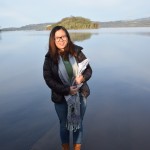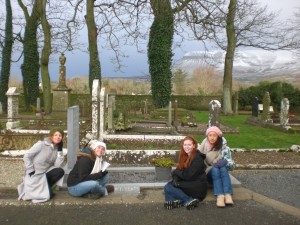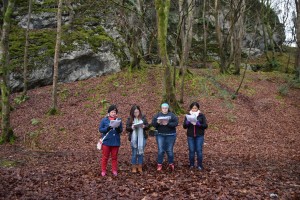 You may not realize that when you go around Ireland with me, you end up reading or listening to poetry and other literature being read aloud in strange but appropriate places. This practice has turned out to be one of the most meaningful aspects of the trips I’ve led, with even seasoned cynics giving in to the pure joy of hearing or speaking the words in the place where they were written, or at the place they were written about, or at a locale that is significant to the text or the author in some way. When I’m traveling with students, they are shy about this practice at first but soon find themselves competing to read certain pieces at certain places.
You may not realize that when you go around Ireland with me, you end up reading or listening to poetry and other literature being read aloud in strange but appropriate places. This practice has turned out to be one of the most meaningful aspects of the trips I’ve led, with even seasoned cynics giving in to the pure joy of hearing or speaking the words in the place where they were written, or at the place they were written about, or at a locale that is significant to the text or the author in some way. When I’m traveling with students, they are shy about this practice at first but soon find themselves competing to read certain pieces at certain places.

Of course we will read the “Proclamation of the Irish Republic” in front of the General Post Office, where Patrick Pearse read it on Easter Monday in 1916. We will read passages from The Islandman when we are standing at the end of the Dingle Peninsula, looking across the sea to the Great Blasket Island (pictured at the top of this page) where Tomás O’Crohan wrote his famous memoir. We will read W. B. Yeats’s poem “Under Ben Bulben” under Ben Bulben, the massive mountain that rises up just beyond Drumcliff Churchyard. Yeats created his own epitaph as the last lines of this poem: “Cast a cold Eye / On life, on Death / Horseman pass by.” So many Yeats poems are tied to the landscape and history of Ireland. The photo at the beginning of this post shows Meiqing Xiong ’16 on our last trip just after she finished reading “The Lake Isle of Innisfree” on a pier in Lough Gill, Sligo, with the eponymous isle in the background. A work of literature comes to mean something more to you when you’ve been to the place it represents, and nearly every student on the trip wants a picture like this one. I’ve linked the poem’s title to a recording of Yeats reading the poem. Listen for the clues to meaning and nuance his voice gives.
One of my favorite Yeats poems is “The Fiddler of Dooney,” included below in full. Yeats based many of his poems on the Celtic legends he heard growing up in Sligo, but this “legend” is one he is said to have made up on his own. I love this little poem for its celebration of poetry and song (the arts), for its whimsical story, and for the line “Folk dance like a wave of the sea.” This photo shows students reading the poem on the shore of Lough Gill with the gigantic “Rock of Dooney” in the background. If you click on the title of the poem in this paragraph, you’ll be able to hear a beautiful musical rendition of the poem by Sean Doyle.
heard growing up in Sligo, but this “legend” is one he is said to have made up on his own. I love this little poem for its celebration of poetry and song (the arts), for its whimsical story, and for the line “Folk dance like a wave of the sea.” This photo shows students reading the poem on the shore of Lough Gill with the gigantic “Rock of Dooney” in the background. If you click on the title of the poem in this paragraph, you’ll be able to hear a beautiful musical rendition of the poem by Sean Doyle.
The Fiddler of Dooney
by W. B. Yeats
When I play on my fiddle in Dooney,
Folk dance like a wave of the sea;
My cousin is priest in Kilvarnet,
My brother in Moharabuiee.I passed my brother and cousin:
They read in their books of prayer;
I read in my book of songs
I bought at the Sligo fair.When we come at the end of time,
To Peter sitting in state,
He will smile on the three old spirits,
But call me first through the gate;For the good are always the merry,
Save by an evil chance,
And the merry love the fiddle
And the merry love to dance:And when the folk there spy me,
They will all come up to me,
With ‘Here is the fiddler of Dooney!’
And dance like a wave of the sea.
(1899)
